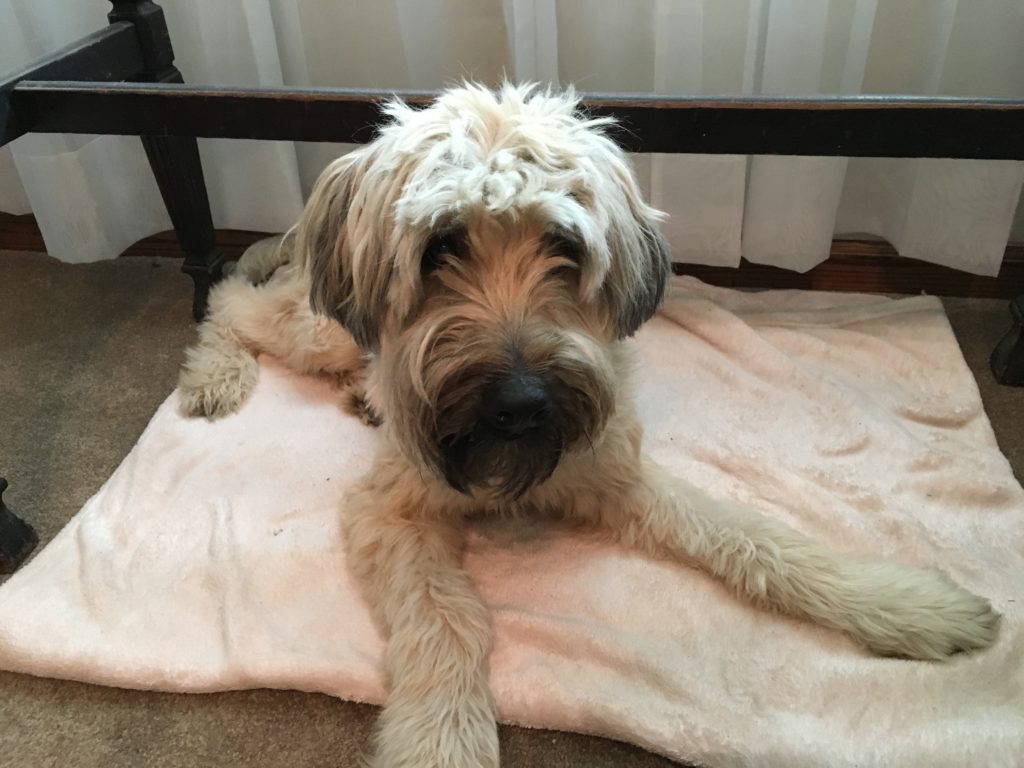Teaching an Excited Wheaten Terrier Some Control to Stop Her Unwanted Behaviors
By: David Codr
Published Date: May 29, 2016
Lola is a three-year-old Soft Coated Wheaten Terrier who got kicked out of dog day care for fixating on specific dogs and not listening when they communicated they didn’t want to play. At home, Lola doesnt always respect her guardians, runs through open doors, jump ups, barks, counter surfs and has excited urination when guests arrive.
Lola showed good curiosity when she met me at the door and was able to greet me without any submissive urination which was an improvement according to her guardian.
Excited urination is all about the dog loosing control. Often times it’s the human’s themselves that put the dog in a position to urinate excitedly. Most humans misinterpret excited to mean happy when it comes to dogs. But excited is just that, excited.
One of the best ways to eliminate the excited urination is for the dog’s guardians to refrain from petting Lola anytime she is in an unbalanced state of mind. Always remember that you are agreeing with whatever a dog is doing at the time you pet it.
So the next time they return home and see Lola bounding around or a visitor arrives and the dog starts to get overexcited, they will need to make sure that no one pets Lola so that she does not get confused and humans do not nurture an unbalanced frame of mind.
Now the flipside of this problem is to ensure that the dog is having its physical needs met. In discussing this with the family, it became clear that Lola was not getting the proper amount of exercise. I strongly recommend that they inquire as to getting a dog walker involved as well as or in combination of teaching Lola to fetch as this is an outstanding activity to burn excess energy.
Managing Lola’s energy output through constructive activities will go a long ways towards eliminating many of her problems behaviors.
Because the family has a young child already and another one on the way, it will be important for Lola to learn boundaries. I spent the next few minutes showing Lola’s as guardians how they can train her to respect personal space.
While there is nothing wrong with the dog being a right up in our personal space, it should be done with an invitation for now. So it will be important for Lola’s guardians to start disagreeing with the dog whenever it decides to get too close on its own. By establishing a healthy respect for their personal space without an invitation, Lola’s guardians can help her learn to incorporate those boundaries around the families young children. In time, Lola will learn that she can get close as long as its done calmly and respectfully.
Because one of her big issues is Lola’s reactivity when other dogs are within eyesight, I wanted to give her guardians a few tools that they can use to distract her as well as practice some dog obedience training.
I started out with the “watch” exercise that I learned from my mentor Karen London, CAAB.
Karen outlines this technique in much more detail in her book Feisty Fido. If you have a dog that is reactive or aggressive to other dogs when on a leash, I strongly recommend you pick up this book. It’s an easy read and the technique is extraordinarily effective.
Another technique that Lola’s guardians can introduce is something called counterconditioning. We headed outside so that I could show the guardians how to apply this technique when dogs are passing near their yard’s fence.
Counterconditioning takes more time than most people are willing to spend, but if done properly, this technique will stop the dog from reacting inappropriately for good.
While I was able to use the counter conditioning technique to stop Lola from getting over excited at the sight of the neighbor dog, this technique is usually more effective when dealing with a dog or object that Lola has a negative association to. That said, as you can see in the above video, the technique can work when the dog is excited because it allows the handler to put the dog into a sit position and ask it to remain that way which helps it develop more self-control.
After we wrapped up the counterconditioning exercise, Lola’s guardian’s mother arrived to assist with their youngest child. I used this opportunity to demonstrate how the guardians can control the door greeting ritual.
I recommended that the family practice this technique with one another rather than leaving it up to random arrivals of guest. By calling or texting one another before they get home, the family can help one another practice this exercise without the added pressure of a guest waiting at the door. Not only will this help stop Lola’s excited urination, it will give her practice at controlling herself.
By the end of the session, Lola was much more relaxed, was showing respect for people’s personal space and already starting to follow the new rules that I had suggested earlier in the session.
If the family can increase Lola’s exercise, preferably early in the day, to a minimum of an hour or more every day, they should notice a strong decline in her unwanted behaviors.
Combined with the new communication methods and leadership structure that we introduced during the session, Lola should quickly understand her place in the family as well develop more control and respect for humans as authority figures. This control should have a positive impact on her habit of focusing on one dog at day care and not listening when a human or dog says “enough.” With some practice, Lola should be able to return to Dog Day care and not get focused or obsessed with playing with any one dog.
Categorized in: Dog Behavior




